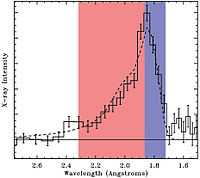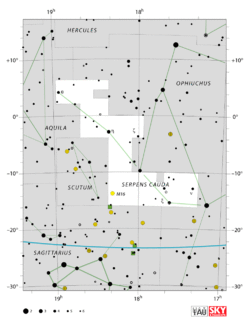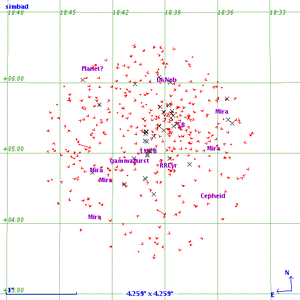Serpens X-1

Serpens X-1 is a more recent designation for an astronomical X-ray source (Serpens XR-1, 'XR' for X-ray) in the constellation Serpens Cauda. It is designated as the first X-ray source discovered overall in the constellation Serpens.
This learning resource is exploratory and experimental, in part, because many subsequent sounding rocket launches, balloon flights, and satellite X-ray scans have apparently found several locations for this early X-ray source.
The research question is "Are any of these subsequent X-ray sources the original Serpens XR-1?"
The number of nearby X-ray sources detected as Serpens X-1 over time suggests that different X-ray sources are being detected by different probes and X-ray observatories. Depending upon the accuracy of location, strength of X-ray signal and possible variation over spectral, temporal, or spatial distributions, the original astronomical X-ray source appears to be missing. This original research effort is ongoing so that researchers or amateur astronomers may enjoy contributing and discussing.
Enjoy learning by doing!
Notations
The astronomical X-number notation (X-#) for an astronomical X-ray source in a constellation has its start from the initial discoverers of an extrasolar X-ray source at the American Science and Engineering Company (ASE)-Massachusetts Institute of Technology (MIT).[2] "[T]he constellation genitive (or an abbreviation) followed by X and a digit, such as SCO X-1 [is applied]."[2] Researchers at the US Naval Research Laboratory suggested "XR" (for X-Ray) rather than "X".[3] This would be SCO XR-1 for the first X-ray source discovered in the constellation Scorpius. "[I]t seems more logical to use this in the standard astronomical notation where the identification precedes the constellation, i.e., X-1 Scorpii."[2] Among the first 17 catalogued astronomical X-ray sources are X1 Scorpii to X3 Scorpii, X1 and X2 Sagittarii, and X1 to X4 Cygni.[2] X1 Serpentis is listed at RA 18h 45m Dec +5° 18'.[2]
Later, the sources became simply the constellation (or an abbreviation) followed by X-#, e.g., Scorpius X-1 (Sco X-1).
Proof of concept for sources
"In some cases, source locations are suspect unless confirmed by two or more separate experimenters."[2]
Entities

Serpens is "split into two non-contiguous parts, Serpens Caput (Serpent's Head) to the west and Serpens Cauda (Serpent's Tail) to the east. Between these two halves lies the constellation of Ophiuchus, the "Serpent-Bearer". ... Stars in the tail include [Zeta Serpentis] ζ, [Eta Serpentis] η, [Theta Serpentis] θ, [Nu Serpentis] ν, [Xi Serpentis] ξ, and [Omicron Serpentis] ο Serpentis."[4]
The image at the right is of Serpens Cauda.
Sources
On June 16, 1964, an Aerobee sounding rocket (probably an Aerobee 150) is launched from the White Sands Missile Range in New Mexico, USA, with zenith coordinates for the epoch 1950.0 of right ascension (RA) 19h 30m, declination (Dec) +32.4°.[5] The rocket is not spin stabilized and rotates around its lengthwise axis while pairs of collimated Geiger counters aboard record incident X-rays.[5]
"On June 16, the rocket reached a peak altitude of 127 km and rolled with a period of about 8.5 seconds. Its precession period was 422 seconds and the precession cone angle was 144°. A solution of the orientation history was obtained to an estimated accuracy of 1.5°."[5]
From the data analysis of the scans, source 'C', designated Ser XR-1, is located at 1950.0 RA 18h 45m Dec 05.3° with flux of 1.5 x 10-8 erg/cm2.s for a computed black body source with temperature of 2 x 107 K for the range in wavelength 0.15-0.8 nm, or 0.3 x 10-8 erg/cm2.s for a computed black body source with temperature of 5 x 106 K for the same wavelength range.[5]
Serpens XR-1, also designated Ser XR-1, is located at epoch B 1950.0 RA 18h 45m Dec +05.3°. This location is from June 16, 1964. A second rocket flight on April 25, 1965, detected Ser XR-1 at the same position and intensity as the June 16th flight.[3]
The current epoch is J 2000.0. This converts the equatorial coordinates to RA 18h 47m 27.68s Dec +05° 21' 20.8". The galactic coordinates are ℓ = 37° 15' 05.7", b = 03° 19' 16.8".
In the image of Serpens Cauda at above right, the location of Serpens XR-1 is in the upper left, farthest left, white, partial rectangle.
According to SIMBAD, for the region centered on J2000.0 RA 18 47 27.68 Dec +05 21 20.8 with an error radius of 1.5° [use region(FK5,18 47 27.68 +05 21 20.8,1.5d) & otype='X'], there are only four X-ray sources as of 2014.07.07: 1RXS J184342.3+060220, 1RXS J184309.9+044341, 1RXS J184245.8+054117, and TYC 460-624-1.
Objects
TYC 460-624-1 is a rotationally variable star. It is X-ray source 1RXS J184510.6+062016.
Astronomical X-ray sources
On March 31, and April 2, 1966, two separate balloon flights detected an X-ray source at approximately B 1950.0 RA 19h ±30m Dec +5° ±10°, with a flux of about 5 x 10-8 ergs cm-2 sec-1, in the energy range from 20 to 180 keV.[6]
"Possible fittings of our distribution, together with the evaluation of the NRL group for ... Ser X1, give an index of 1.6 for a power law and a temperature of 2 x 109 °K for an exponential law ... Independently of the mechanism invoked, a black-body source would appear to be excluded: the high energies involved will demand extraordinary conditions in the [source], such as strong magnetic fields and high electron energies or hot dense plasmas at quite unusual temperatures."[6]
The "[b]alloon measurements ... observed ... [a flux] (20 to 180 kev) from Ser XR-1 [of] about 8 x 10-8 erg/cm2ˑsec"[3].
On May 15, 1967, a balloon flight, designated 296-P, observed X-ray counts in the direction for Serpens XR-1 using the NRL coordinates.[7] The flight used the same gondola and detector, a 56.3-cm2 NaI crystal and a collimator with 8.4° full-width-at-half-maximum (FWHM) field of view, as used in earlier and later balloon flights.[7] In the energy range of 16.6 to 23.4 keV the detector registered < 0.075 counts/second source rate for Serpens XR-1.[7] In the range 23.4-46.7 keV, the count rate was 0.124±0.130.[7] For the same ranges the detector also observed Scorpius X-1 at 0.243 and 0.098 counts/second (cts/s), suggesting that the source emission ratios were < 0.309 and 1.27 of Scorpius X-1, respectively.[7]
"A Hydra-Iris rocket was launched from the open ocean 500 miles off the coast of Baja California [on November 3, 1968, at 18h00m UTC], at latitude 27.4 N and longitude 125 W."[8] Ser XR-1 was observed at a galactic longitude of 36.0°.[8] Ser XR-2 was at 16.5° in galactic longitude.[8] The galactic longitude for Ser XR-1 (NRL) is 37° 15' 05.7". The source observed on November 3, 1968, is just short of 2° from Ser XR-1.
"The strength of these sources [Ser XR-1 at 0.8 photons cm-2 sec-1 and Ser XR-2 at 2.1 photons cm-2 sec-1] is about the same as that observed by NRL on 1965 April 25 (Friedman et al. 1967). Ser XR-1 seems to be strongest at low energies and has a shape similar to that of the Crab Nebula. The background subtraction for Ser XR-2 is a bit uncertain because of the nearness of other sources. Nevertheless, our result is reasonably close to that of the 1965 October 11 experiment of Gorenstein et al. (1967). The 1965 September 30 experiment of Fisher et al. (1967) is similar in shape but lower in intensity."[8]
Uhuru X-ray sources

The Uhuru satellite detected an X-ray source at 2U 1836+05.[9] The exact position was listed as B 1950.0 RA 18 36 29 Dec +05 02 24. In an error box with corners: RA 18 36 51 Dec +05 02 24, RA 18 35 34 Dec +05 05 06, RA 18 35 34 Dec +05 03 00, and RA 18 36 48 Dec +04 59 24. The authors designated the 2U 1836+05 source as Ser XR-1. But this did not include the final position for this source at 4U 1837+04.
By December 5, 1977, at least five other positions, in epoch 1950.0 coordinates, for Serpens XR-1 are indicated
- RA 18h 37m 29.8s Dec +04° 59' 23",
- GX +36.3,
- 4U 1837+04,
- MXB 1837+049, and
- 2S 1837+049.[10]
These have been observed by sounding rocket on
- November 25, 1964, over the range 0.15-0.8 nm,
- April 25, 1965, over the range 0.15-0.8 nm,
- September 30, 1965, over the range 0.4-0.8 nm,
- October 11, 1966, over the range 0.2-0.5 nm,
- September 24, 1970, over the range 0.12-1.6 nm, and
- May 25, 1971, over the range 0.2-0.6 nm.[10]
Subsequent satellite observations are
- Uhuru, 1971-73, over the range 0.2-0.6 nm,
- Ariel, in November 1974, over the range 0.2-1.8 nm,
- SAS 3, October 4-7, 1975, over the range 0.2-2.4 nm,
- SAS 3, August 22-28, 1976, over the range 0.2-1.1 nm, and
- SAS 3, 1975-77, over the range 0.2-1.1 nm.[10]
The SIMBAD astronomical database has Serpens XR-1 located at epoch 2000.0 RA 18h 39m 57.56s Dec +05° 02' 09.6".
The image at right is a celestial map of the astronomical sources within the 1.5° radius error circle around Serpens X-1, not Serpens XR-1. The other sources, or astronomical objects, within this error circle are stars (*), additional X-ray sources (X), a gamma-ray burst source (gammaBurst), and a dark nebula (DkNeb).
XMM-Newton source
The image at the top right is a graph of the "XMM-Newton spectral signature from superheated iron atoms at the inner edge of the accretion disk orbiting the neutron star in Serpens X-1. Normally, the line would be a symmetrical peak, but it exhibits the classic features of distortion due to relativistic effects. The extremely fast motion of the iron-rich gas causes the line to spread out. The entire line has been shifted to longer wavelengths (left, red) because of the neutron star's powerful gravity. The line is brighter toward shorter wavelengths (right, blue) because Einstein's special theory of relativity predicts that a high-speed source beamed toward Earth will appear brighter than the same source moving away from Earth."[1]
"As of August 27, 2007 discoveries concerning asymmetric iron line broadening and their implications for relativity have been a topic of much excitement. With respect to the asymmetric iron line broadening, Edward Cackett of the University of Michigan commented,"[11]
"We're seeing the gas whipping around just outside the neutron star's surface,". "And since the inner part of the disk obviously can't orbit any closer than the neutron star's surface, these measurements give us a maximum size of the neutron star's diameter. The neutron stars can be no larger than 18 to 20.5 miles across, results that agree with other types of measurements."[12]
"We've seen these asymmetric lines from many black holes, but this is the first confirmation that neutron stars can produce them as well. It shows that the way neutron stars accrete matter is not very different from that of black holes, and it gives us a new tool to probe Einstein's theory", says Tod Strohmayer of NASA's Goddard Space Flight Center.[12]
"This is fundamental physics", says Sudip Bhattacharyya also of NASA's Goddard Space Flight Center in Greenbelt, Maryland and the University of Maryland. "There could be exotic kinds of particles or states of matter, such as quark matter, in the centers of neutron stars, but it's impossible to create them in the lab. The only way to find out is to understand neutron stars."[12]
"Using XMM-Newton, Bhattacharyya and Strohmayer observed Serpens X-1, which contains a neutron star and a stellar companion. Cackett and Jon Miller of the University of Michigan, along with Bhattacharyya and Strohmayer, used Suzaku's superb spectral capabilities to survey Serpens X-1. The Suzaku data confirmed the XMM-Newton result regarding the iron line in Serpens X-1.[12]"[11]
The observations of the iron line asymmetric broadening using XMM-Newton of a Serpens X-1 (the LMXB) as reported in 2007 do not contain coordinates for the X-ray source.[13]
Research
Hypothesis:
- The first source believed to be Serpens X-1 is probably not as exciting as the currently accepted source.
Control groups

The findings demonstrate a statistically systematic change from the status quo or the control group.
“In the design of experiments, treatments [or special properties or characteristics] are applied to [or observed in] experimental units in the treatment group(s).[14] In comparative experiments, members of the complementary group, the control group, receive either no treatment or a standard treatment.[15]"[16]
Proof of concept
Def. a “short and/or incomplete realization of a certain method or idea to demonstrate its feasibility"[17] is called a proof of concept.
Def. evidence that demonstrates that a concept is possible is called proof of concept.
The proof-of-concept structure consists of
- background,
- procedures,
- findings, and
- interpretation.[18]
See also
References
- 1 2 "File:187900main colorpress1 lg.jpg, In: Wikimedia Commons". San Francisco, California: Wikimedia Foundation, Inc. November 4, 2012. Retrieved 2012-07-17.
- 1 2 3 4 5 6 Gerald A. Ouellette (June 1967). "Development of a Catalogue of Galactic X-Ray Sources". The Astronomical Journal 72 (5): 597-600. doi:10.1086/110278.
- 1 2 3 H. Friedman, E. T. Byram, T. A. Chubb (April 1967). "Distribution and Variability of Cosmic X-Ray Sources". Science 156 (3773): 374-8. doi:10.1126/science.156.3773.374.
- ↑ "Serpens, In: Wikipedia". San Francisco, California: Wikimedia Foundation, Inc. September 3, 2013. Retrieved 2013-09-07.
- 1 2 3 4 S. Bowyer, E. T. Byram, T. A. Chubb, and H. Friedman (February 1965). "Observational results of X-ray astronomy". Annales d'Astrophysique 28 (2): 791-803.
- 1 2 D. Brini, U. Ciriegi, F. Fuligni, E. Moretti, and G. Vespignani (August 1967). "Cosmic X-Ray Sources in the 20-180 keV Energy Range". The Astrophysical Journal 149 (8): 429-33. doi:10.1086/149267.
- 1 2 3 4 5 James W. Overbeck and Harvey D. Tananbaum (September 1968). "Time Variations in Scorpius X-1 and Cygnus XR-1". The Astrophysical Journal 153 (09): 899-908. doi:10.1086/149714. http://adsabs.harvard.edu/abs/1968ApJ...153..899O. Retrieved 2013-09-08.
- 1 2 3 4 A. MacGregor, F. Seward, and I. Turiel (September 1970). "Observation of Galactic X-ray Sources 1968 November 3". The Astrophysical Journal 161: 979-85. doi:10.1086/150598. http://adsabs.harvard.edu/abs/1970ApJ...161..979M. Retrieved 2013-09-08.
- ↑ R. Giacconi, S. Murray, H. Gursky, E. Kellogg, E. Schreier, and H. Tananbaum (December 1, 1972). "The Uhuru Catalog of X-ray Sources". The Astrophysical Journal 178 (12): 281-308. doi:10.1086/151790. http://adsabs.harvard.edu/abs/1972ApJ...178..281G. Retrieved 2014-07-06.
- 1 2 3 P. R. Amnuel, O. H. Guseinov, and Sh. Yu. Rakhamimov (October 1979). "A catalog of X-ray sources". The Astrophysical Journal Supplement Series 41 (10): 327-67. doi:10.1086/190621.
- 1 2 "History of X-ray astronomy, In: Wikipedia". San Francisco, California: Wikimedia Foundation, Inc. June 24, 2012. Retrieved 2012-07-17.
- 1 2 3 4 Gibb M,Bhattacharyya S, Strohmayer T, Cackett E, Miller J. "Astronomers Pioneer New Method for Probing Exotic Matter".
- ↑ Sudip Bhattacharyya and Tod E. Strohmayer (August 1, 2007). "Evidence of a Broad Relativistic Iron Line from the Neutron Star Low-Mass X-ray Binary Serpens X-1". The Astrophysical Journal 664 (2): L103-. doi:10.1086/520844. http://iopscience.iop.org/1538-4357/664/2/L103. Retrieved 2014-07-06.
- ↑ Klaus Hinkelmann, Oscar Kempthorne (2008). Design and Analysis of Experiments, Volume I: Introduction to Experimental Design (2nd ed.). Wiley. ISBN 978-0-471-72756-9. http://books.google.com/?id=T3wWj2kVYZgC&printsec=frontcover.
- ↑ R. A. Bailey (2008). Design of comparative experiments. Cambridge University Press. ISBN 978-0-521-68357-9. http://www.cambridge.org/uk/catalogue/catalogue.asp?isbn=9780521683579.
- ↑ "Treatment and control groups, In: Wikipedia". San Francisco, California: Wikimedia Foundation, Inc. May 18, 2012. Retrieved 2012-05-31.
- ↑ "proof of concept, In: Wiktionary". San Francisco, California: Wikimedia Foundation, Inc. November 10, 2012. Retrieved 2013-01-13.
- ↑ Ginger Lehrman and Ian B Hogue, Sarah Palmer, Cheryl Jennings, Celsa A Spina, Ann Wiegand, Alan L Landay, Robert W Coombs, Douglas D Richman, John W Mellors, John M Coffin, Ronald J Bosch, David M Margolis (August 13, 2005). "Depletion of latent HIV-1 infection in vivo: a proof-of-concept study". Lancet 366 (9485): 549-55. doi:10.1016/S0140-6736(05)67098-5. http://www.ncbi.nlm.nih.gov/pmc/articles/PMC1894952/. Retrieved 2012-05-09.
Further reading
- S. Bowyer, E. T. Byram, T. A. Chubb, and H. Friedman (February 1965). "Observational results of X-ray astronomy". Annales d'Astrophysique 28 (2): 791-803.
External links
- African Journals Online
- Bing Advanced search
- Google Books
- Google scholar Advanced Scholar Search
- International Astronomical Union
- Is My Favorite Object an X-ray, Gamma-Ray, or EUV Source?
- JSTOR
- Lycos search
- NASA/IPAC Extragalactic Database - NED
- NASA's National Space Science Data Center
- Office of Scientific & Technical Information
- Questia - The Online Library of Books and Journals
- SAGE journals online
- The SAO/NASA Astrophysics Data System
- Scirus for scientific information only advanced search
- SDSS Quick Look tool: SkyServer
- SIMBAD Astronomical Database
- Spacecraft Query at NASA.
- SpringerLink
- Taylor & Francis Online
- Universal coordinate converter
- Wiley Online Library Advanced Search
- Yahoo Advanced Web Search
![]() This is a research project at http://en.wikiversity.org
This is a research project at http://en.wikiversity.org
| |
Development status: this resource is experimental in nature. |
| |
Educational level: this is a research resource. |
| |
Resource type: this resource is an article. |
| |
Resource type: this resource contains a lecture or lecture notes. |
| |
Resource type: this resource is a lesson. |
| |
Subject classification: this is an astronomy resource. |
| |
Subject classification: this is an astrophysics resource. |